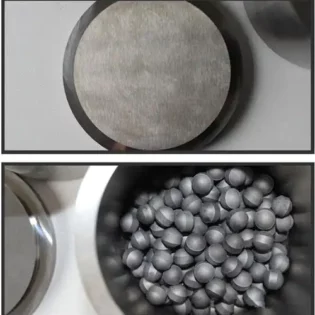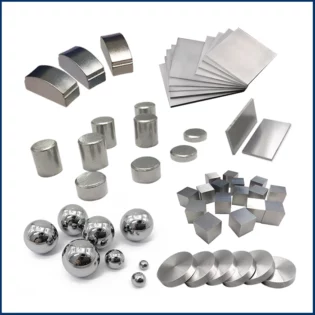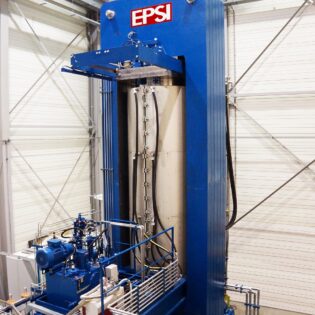When WC grains in cemented carbide are less than 0.5 μ m, the finer the grains are, the fewer the defects are, and the higher the bending strength and hardness are The particle size of WC powder used to produce ultrafine cemented carbide is much smaller than that of WC powder used in general cemented carbide. The WC powder has high activity and is easy to cause grain growth in the sintering process, which is one of the crack sources.
At present, there are two main methods to control the grain size:
First, a new sintering process is adopted. The results show that the densification of dozens of nano WC Co composite powders can be completed after sintering at 1400 ℃ for 30s, and the grain size is 0.2 μ m, but if the sintering time is extended to 60s, the grain size will grow rapidly to 2.0 μ M. The new sintering processes that can be used for nano WC Co cemented carbide composite powder mainly include microwave sintering, hot isostatic pressing sintering, discharge plasma sintering and two-stage sintering.
Second, adding inhibitors of grain growth to inhibit grain growth, VC, TAC and Cr3C2 are often used inhibitors.
In this paper, the inhibition mechanism, the factors affecting the effect of inhibitors, the way of adding inhibitors, the commonly used inhibitors, the development of the latest inhibitors and the influence of inhibitors on the comprehensive properties of alloys are introduced.

Inhibition mechanism and influencing factors of inhibitors
The driving force for the grain growth of cemented carbide comes from the reduction of surface energy. The grain growth of WC is mainly through the dissolution precipitation mechanism of WC, that is, small grain WC dissolves in the liquid phase and precipitates on the surface of large grain WC. For WC Co cemented carbides, the coarsening of WC grains can be limited by the addition of grain growth inhibitors.
The addition of inhibitors slows down the dissolution precipitation rate of WC, and there are three inhibition mechanisms:
1. The inhibitor adsorbs on the surface of carbide particles, which reduces the surface energy of WC and the solubility of WC in liquid phase.
2. The inhibitor dissolves in liquid CO, which slows down the growth of WC through liquid recrystallization.
3. The migration of WC interface was hindered by the segregation of inhibitors along WC / WC interface, which prevented the aggregation and growth of WC particles.
The inhibition effect of inhibitors is determined by the following factors:
1. Decreasing the particle size of WC powder increases the grain boundary area of WC Co. inhibitors can be widely distributed on the surface of WC, but they can not be increased indefinitely. Their limit value depends on their saturation concentration in the bonding phase.
2. Cobalt content. With low content of binder and short free stroke, the inhibitor is easy to play its role at a certain temperature.
3. Uniformity of powder mixing. The uneven distribution of the binder phase in the mixed powder will lead to the difference of the effect area of inhibitors on WC grain growth in the sintering process; the uneven distribution or large size of the inhibitors in the mixed powder will lengthen the diffusion route required by the inhibitors
4. Alloy sintering temperature. With the increase of sintering temperature, the amount of liquid phase and the content of grain growth inhibitor need to be increased in order to keep the high concentration of inhibitor in the liquid phase Therefore, the smaller the powder size, the lower the cobalt content, the more uniform the powder mixing and the lower the sintering temperature are, the better the inhibition effect of the inhibitor is.

Adding ways of grain growth inhibitor
Inhibitors are mainly added in three ways:
1. WC, CO and grain growth inhibitor were mixed in the wet grinding process.
2. Before w carbonization, oxide corresponding to grain growth inhibitor was mixed.
3. The third method is to wet mix the salt solution of the inhibitor with blue tungsten or yellow tungsten, and form coating powder with blue tungsten or yellow tungsten before reduction, and then conduct further thermal decomposition and reduction.

Types of grain growth inhibitors
Transition metal carbides
Transition metal carbides are common inhibitors of grain growth. The effectiveness of transition metal carbides in inhibiting WC grains is related to their own thermodynamic stability. The order of their thermodynamic stability is VC > Cr3C2 > NBC > TAC > tic > ZrC > HFC. However, each kind of carbide has a maximum amount that can be added, which has no further effect on inhibiting the growth of WC grains. At a certain temperature, the amount of carbide additives depends on the saturation concentration of the carbide in the binder phase and the content of the binder phase Table 2 shows the solubility of various additives in CO phase. It can be seen from the table that VC and Cr3C2 have the highest solubility in CO phase and they have the lowest binary eutectic temperature, so they are widely used as WC Co grain growth inhibitors.

Rare earth element
Rare earth element is one of the common additives, which can inhibit the grain growth, improve the structure distribution, purify the grain boundary, and play an effective role in strengthening and toughening the cemented carbide. At the same time, rare earth can also reduce the sintering temperature of cemented carbide, which can solve the contradiction between controlling grain growth and Sintering Densification. the increase of the macro compressive stress on the alloy surface is also an important reason for the increase of the strength of WC Co cemented carbide by the addition of rare earth oxides.
Boron and phosphorus
It is found that the sintering temperature of the cemented carbide with boron can be reduced to 1340 ℃, with the decrease of sintering temperature, the micro grains of the alloy are obviously refined, which is conducive to the improvement of the alloy performance, and the addition of boron has little effect on the wettability of the bonding phase and WC phase, and the bending strength of the alloy is not affected. The sintering temperature of WC Co can be reduced to 1050-1100 ℃ by adding a small amount of Ni and P powder. The mechanism is that the eutectic temperature of Ni-P is far lower than the melting point of Co. after adding Ni and P, the liquid phase can appear at a lower temperature, which makes the dissolution and precipitation of solid particles and the formation of framework occur in advance, and the sintering process is more sufficient, thus inhibiting the growth of WC grains.
Copper molybdenum metal inhibitor
The addition of a small amount of Cu to wc-13fe / Co / Ni cemented carbide can refine the spheroidized WC grains. This is mainly because Cu will dissolve into the Fe / Co / Ni binder during the sintering process, reducing the solubility of WC in the binder, thus reducing the rate of grain growth during the dissolution re precipitation process. And copper also spheroidizes WC grains. In the sintering process of cemented carbide, molybdenum is coated around the cemented phase, which improves the wettability between the cemented phase and the cemented phase, so as to refine the particles of cemented phase
Effect of grain growth inhibitor on properties of alloy
The effect of grain growth inhibitors on the properties of the alloy is mainly reflected in the hardness and bending strength of the alloy Different additives have different mechanisms of inhibiting grain size, so different inhibitors of grain growth have different effects on properties.
Transition metal carbides
The addition of VC, Cr 3C 2 and other additives can effectively improve the heat resistance and wear resistance of WC Co cemented carbide. Moreover, the high temperature strength and high temperature hardness of the alloy can be effectively improved when the additive is appropriate, but the room temperature strength of the alloy can be reduced and the alloy becomes brittle. Therefore, the amount of additives must be controlled within a certain range For example, for WC-6% CO and WC-10% Co alloys, the addition of cr2c3 reduced the room temperature bending strength of the alloy. When the content of Cr 2C 3 is 0.3% ~ 0.5% (mass fraction of CO content), the room temperature bending strength of the high Co alloy will not be affected obviously, but for the low Co alloy, the room temperature bending strength will be decreased obviously. Adding TAC and NBC will result in the same result The effect of VC on the microstructure and properties of wc-6.5% Co cemented carbides was found. It was found that VC inhibited the growth of WC grains, which resulted in obvious grain refinement and narrowed the distribution of grain size. The grain size decreased from 0.5-1 μ m without adding VC to 0.15 μ m with adding 2.0% VC. At the same time, the hardness of the alloy is greatly improved by adding VC, and the maximum value is 94.1 HRA when VC content is 2.0%. But it also reduces the strength of the alloy When VC content is 0.5%, the hardness and toughness of the alloy are 93.0hra and 11.2MPa · M 1 / 2, and the comprehensive properties are the highest. The addition of TAC can not only prevent the WC grains from growing too much, but also reduce the carbon content of the alloy
Rare earth element
The hardness of WC-20 (Fe / Co / Ni) alloy increased with the increase of rare earth content. The addition of rare earth can improve the properties of w-co-ti alloy, especially improve the impact resistance of Shejin. At the same time, rare earth can inhibit the grain aggregation and growth of (Ti, w) C solid solution and refine the grain. When rare earth oxide is added to WC Ni alloy, the strength of bonding phase Ni increases due to dispersion strengthening of rare earth oxide. When the rare earth content is 1.2% ~ 1.6% of bonding metal content, the bending strength of the alloy reaches the maximum value (1680mpa when CeO 2 is added, 1900mpa when Y2O3 is added). The bending strength of WC-8% Co alloy is increased to a certain extent by adding 0.25% ~ 1.00% of the mixed rare earth oxide, and it can be increased by 11.5% when adding 0.25% ~ 0.50% of the rare earth oxide, but the excessive addition of rare earth will lead to the decrease of the bending strength. Therefore, the bending strength of cemented carbide with rare earth elements can be greatly improved.
Cu&Mo metal inhibitors
Adding a small amount of copper into the cemented carbide can not only improve the strength of the alloy, but also improve the impact toughness of the alloy.
When a small amount of copper is added to WC-13% Fe / Co / Ni, the hardness of the alloy decreases, while the bending strength increases greatly. When the amount of copper is about 0.8%, the bending strength and hardness of the alloy are 2370 MPa and hra84.4 respectively. See Table 3 below. When Mo was added to WC Co, the bending strength and India increased with the increase of Mo addition. The bending strength reached the maximum value when Mo addition was 5%, and reached the peak value of 19.25gpa when Mo addition was 7.5%. However, when the amount of Mo is more than 5%, the bending strength decreases gradually, which is due to the embrittlement of the sample caused by the presence of intermetallic compound CO3(Mo, w)3C.










